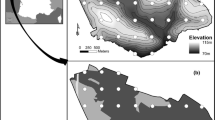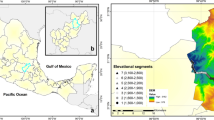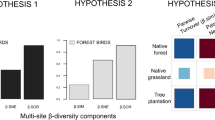Abstract
In this study, we obtained data on the structure of two intra-seasonal breeding bird assemblages of a Mediterranean low-altitude beech forests (about 400 m a.s.l.), an ecosystem type of high eco-biogeographic interest and little known in this sense. We sampled 22 breeding bird species (20 sedentary species and two long migrants) with the point count method. Both mean values of species richness and abundance increased from March–April to May–June periods, but differences were not significant. The Shannon diversity index showed a weak increase between early and late spring. We observed an increase of α, β and γ-diversity values from early to late spring. Diversity dominance curves showed a partial coincidence between the two intra-seasonal periods, with a significant difference in slope. Although our low-altitude beech forest showed a relatively low number of species, we observed higher values of total abundance when compared with other beech forests of Central Italy at higher altitude. As a confirmation, our null model analyses of niche overlap revealed no non-random patterns of the temporal distribution of sightings, thus widely supporting the general hypothesis that the bird assemblages of low-altitude beech forests are indeed stable intra-seasonally. The only observed differences between assemblages in the two intra-seasonal periods are limited to the occurrence of two migrant species in the late-spring assemblage (Oriolus oriolus and Upupa epops) that change the slope of the relative diversity/dominance curve (significant different to the early spring curve). Although previous research highlighted the role of altitude in influencing species richness and abundance, this is the first study to analyze the intra-seasonal structure of bird assemblages inhabiting Mediterranean beech forests at low altitude.


Similar content being viewed by others
References
Anzalone B (1961) Osservazioni fitosociologiche su alcune faggete depresse del Lazio. Ann Bot 27:120–134
Battisti C, Guidi A (2010) Comparing spatial rarity between long distance migrant and sedentary bird species using atlas data and diversity/dominance diagrams. Vie Milieu 60:321–326
Battisti C, Vignoli L, Bologna MA (2010) Breeding birds in an Appennine Massif (Majella, central Italy): do “common species” could act as surrogate for characterize species richness and composition of the communities? Ekologia (Bratislava) 29:207–218
Bibby CJ, Burgess ND, Hill DA, Mustoe SH (2000) Bird census techniques, vol 2. Academic Press, London
Blasi C (1994) Fitoclimatologia del Lazio. Fitosociologia 27:151–175
Contoli L, Lombardi G, Spada F (1980) Piano per un Parco naturale nel territorio di Allumiere e Tolfa (Lazio). Istituto Poligrafico e Zecca dello Stato, Roma
Fanelli G, Bianco M (2007) Memorie illustrative della Carta della vegetazione reale della Provincia di Roma. Assessorato alle Politiche del territorio, Provincia di Roma, pp 1–119
Farina A (1980) Effects of forest exploitation on the beechwood birds of the Southern Apennines. Avocetta 4:141–145
Farina A (1995) Distribution and dynamics of birds in a rural sub-Mediterranean landscape. Landsc Urb Plan 31:269–280
Fusco E, Tellini Florenzano G (2008) Composizione e struttura della comunità ornitica nidificante in una faggeta della Basilicata. Avocetta 32:55–60
Ghazoul J (2002) Impact of logging on the richness and diversity of forest butterflies in a tropical dry forest in Thailand. Biodiv Conserv 11:521–541
Helle P, Fuller RJ (1988) Migrant passerine birds in European forests successions in relation to vegetation height and geographical position. J Anim Ecol 57:565–579
Hofmann A (1991) Il faggio e le faggete in Italia. Collana Verde 81. Corpo Forestale dello Stato, Roma
Korňan M (2004) Structure of the breeding bird assemblage of a primaeval beech-fir forest in the Srámková National Nature Reserve, the Malá Fatra Mts. Biologia (Bratislava) 59:219–231
Korňan M, Adamik P (2007) Foraging guild structure within a primaeval mixed forest bird assemblage: a comparison of two concepts. Comm Ecol 8:133–149
Kropil R (1996) Structure of the breeding bird assemblage of the fir-beech primeval forest in the West Carpathians (Badín nature reserve). Folia Zool 45:311–324
Lorenzetti E, Vuerich V, Ukmar E, Battisti C (2007) La comunità ornitica nidificante nella faggeta depressa del SIC “Boschi mesofili di Allumiere” (Lazio, Italia centrale). Alula 14:73–77
Magurran A (2004) Measuring biological diversity. Blackwell Publishing, Malden
Manzi A (1991) Primi dati sull’avifauna nidificanti nelle associazioni forestali della Foresta Umbra (Gargano). Atti Soc Italiana di Ecol 12:433–437
Provincia di Roma (2007) Carta della vegetazione reale della provincia di Roma. Scala 1: 50.000. Provincia di Roma, Assessorato alle Politiche del territorio, Roma
Regione Lazio (2004) La rete Natura 2000 nel Lazio. Caratterizzazione dei Siti di Importanza Comunitaria e delle Zone di protezione Speciale per l’attuazione della sottomisura I.1.2, vol 2. Assessorato Ambiente, Regione Lazio, pp 1–239
Sarrocco S, Sorace A (1997) La comunità di uccelli nidificanti in due ambienti forestali della Riserva naturale “Lago di Vico” (Lazio, VT). Riv ital Orn 67:71–74
Shannon CE, Weaver W (1963) Mathematical theory of communication. University of Illinois Press, Urbana
Van Dorp D, Opdam PFM (1987) Effects of patch size, isolation and regional abundance on forest bird communities. Landsc Ecol 1:59–73
Vuerich V, Bologna MA, Battisti C (2006) Comunità ornitiche nidificanti in tre tipologie vegetazionali lungo un gradiente altitudinale nei monti Simbruini (Lazio, Appennini centrali) (Aves). Aldrovandia 2:49–53
Whittaker RH (1960) Vegetation of the Siskiyou Mountains, Oregon and California. Ecol Monogr 30:279–338
Wiens JA (1976) Population responses to patchy environments. Annu Rev Ecol Syst 7:81–120
Wiens JA (1989) The ecology of bird communities. Processes and variations, vol 2. Cambridge Univ Press, Cambridge
Acknowledgments
We would like to acknowledge Francisco Javier Oficialdegui and Emanuela Lorenzetti for their help in the field work, and two anonymous reviewers for their useful suggestions.
Author information
Authors and Affiliations
Corresponding author
Electronic supplementary material
Below is the link to the electronic supplementary material.
Rights and permissions
About this article
Cite this article
Ferraguti, M., Battisti, C., Luiselli, L. et al. Breeding bird assemblages in a Mediterranean mature beech forest: evidence of an intra-seasonal stability. Rend. Fis. Acc. Lincei 24, 1–5 (2013). https://doi.org/10.1007/s12210-012-0206-0
Received:
Accepted:
Published:
Issue Date:
DOI: https://doi.org/10.1007/s12210-012-0206-0




